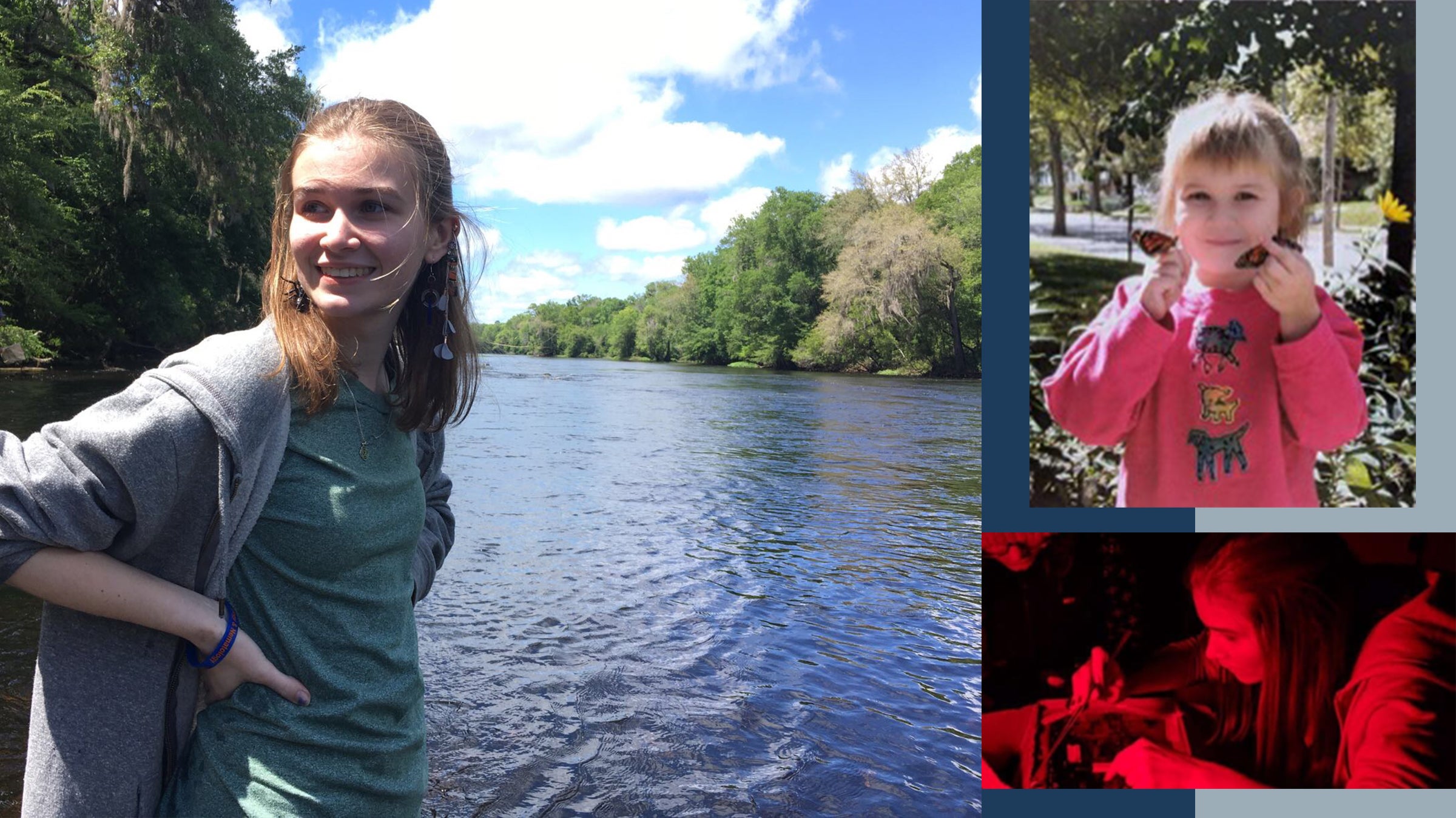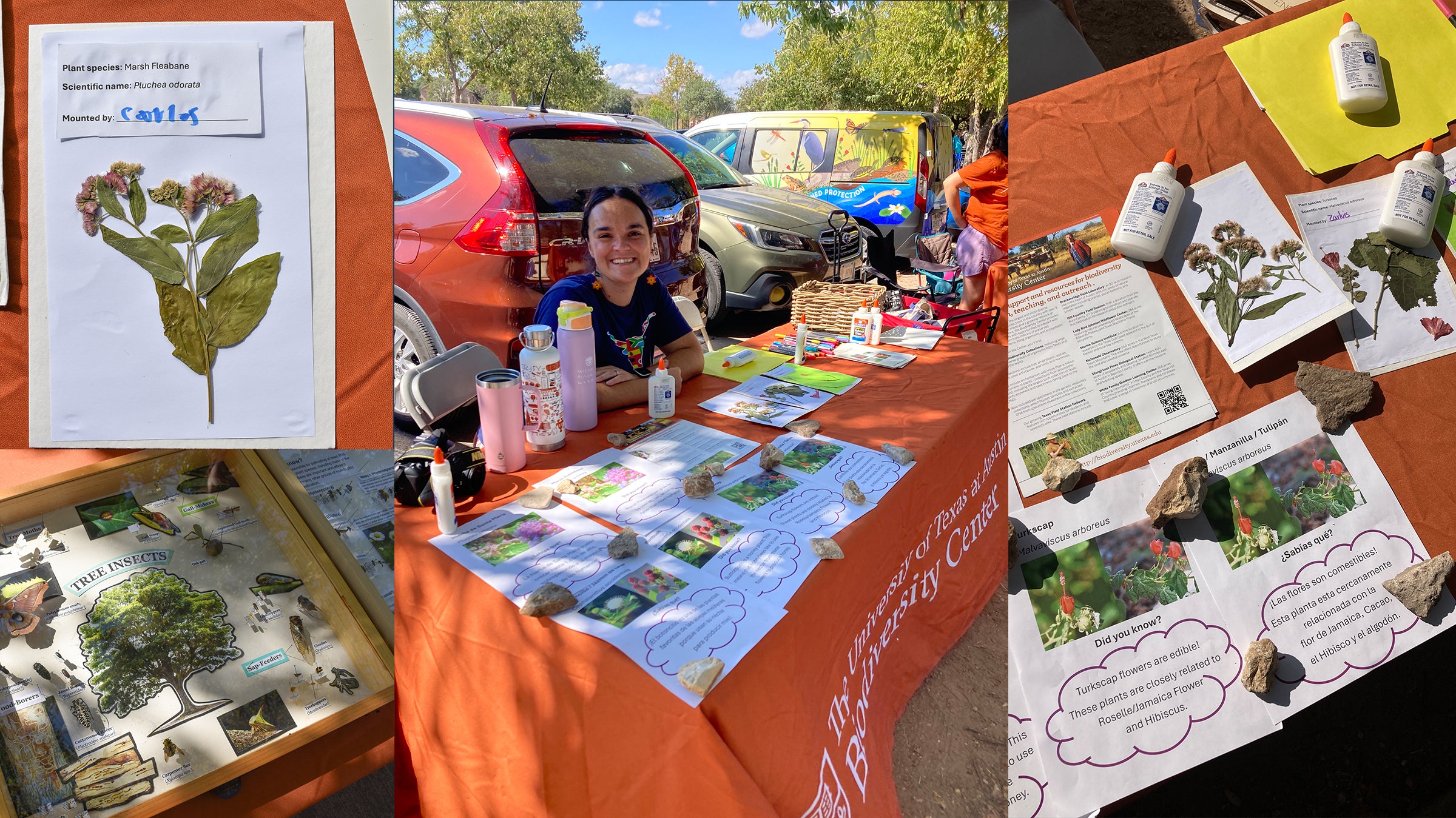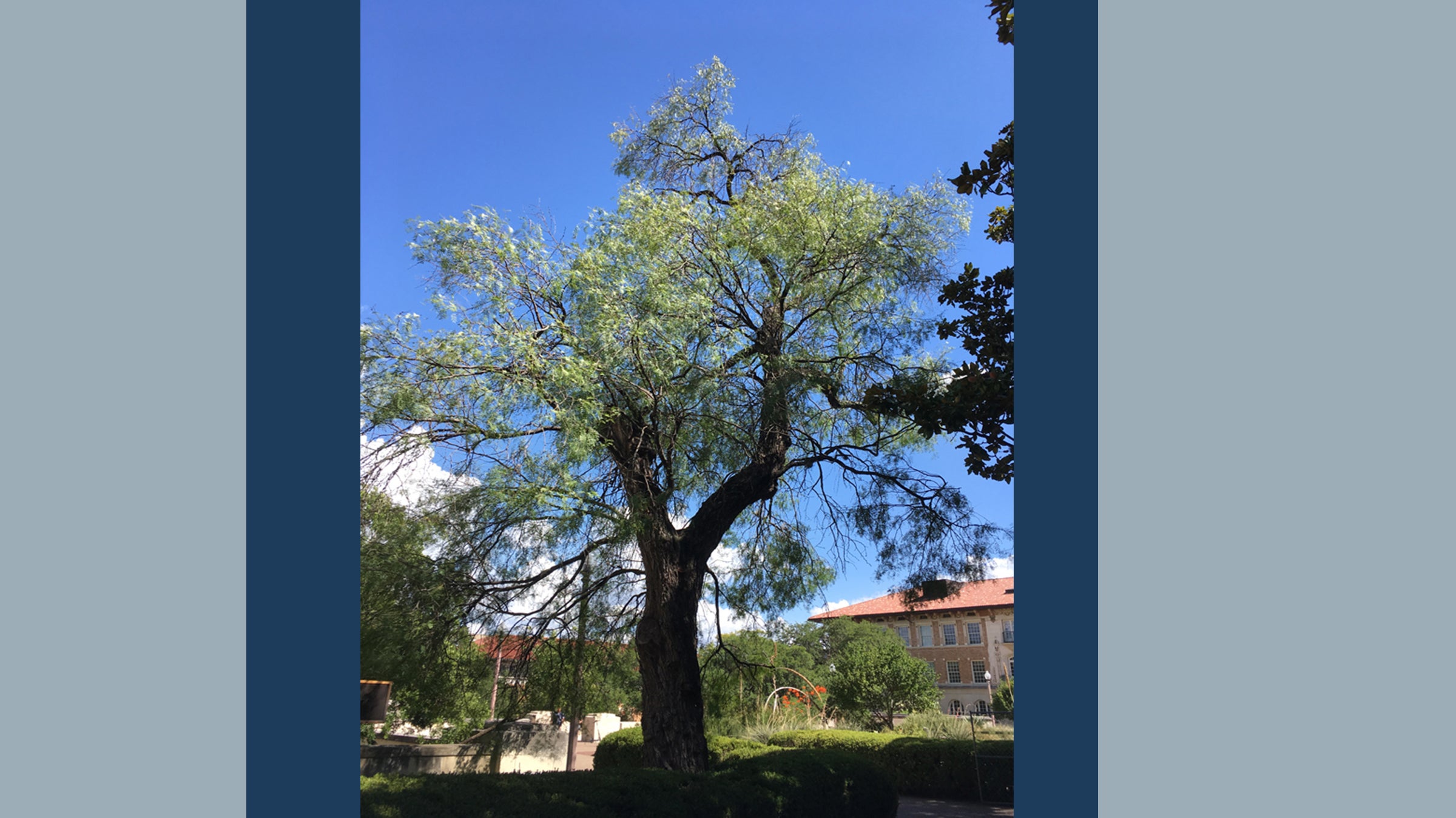
An old mesquite on east side of the Main Tower on the UT campus, near the WCH building.
If you were a student at UT when the university was founded in 1883, you might have ridden a horse-drawn carriage by quite a few mesquite to get to class. Gradually with campus expansion, mesquite became fewer in number. Now only a few remain on campus. One of the oldest Prosopis individuals is on the east side of the Main Tower.
Mesquite is a woody legume belonging to the same family (Fabaceae) that includes peanuts, alfalfa and beans. They can grow to be a shrub or tree-height at maturity depending on ecoregion and habitat. All three subspecies of honey mesquite (var. glandulosa, var. prostrata, and var. torreyana) are found across Texas, with the exception of the most eastern part of the state as these plants do not compete well with forests that grow tall in wetter soils. Here in Austin, mesquites are well-suited for our hot and dry climate. When underground water is available, they can grow a long taproot that can grow over 100 feet. This taproot is also used for firewood and indigenous groups used it for bow wood.
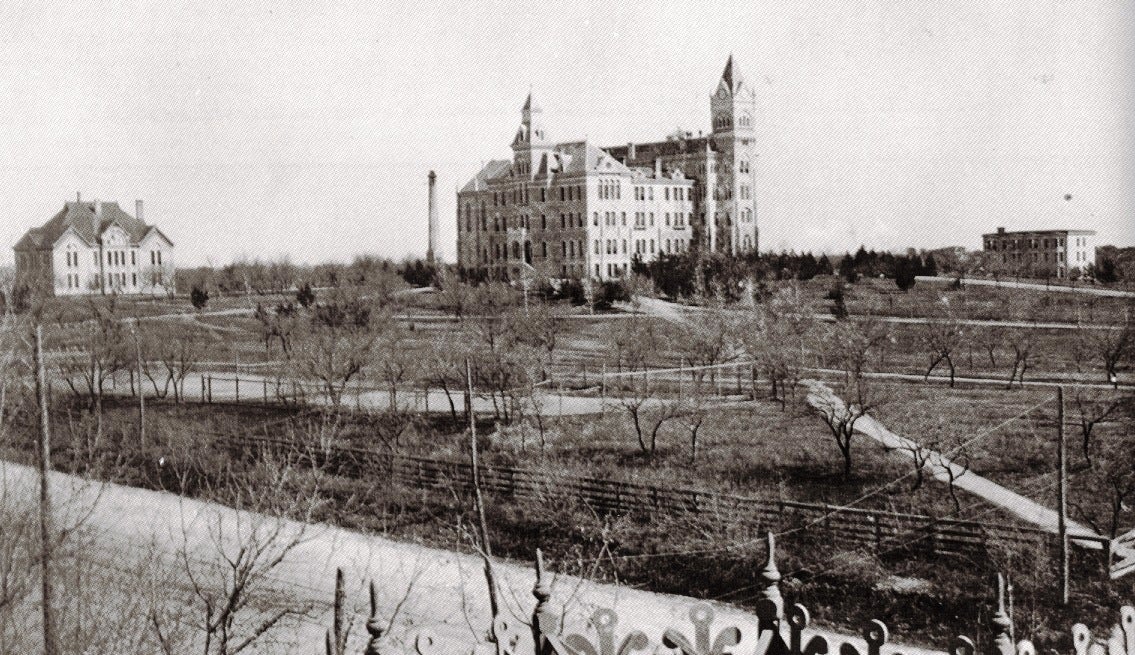
UT Austin campus in the late 1880s when there were more mesquite trees.
Mesquite are virtually immune to disease and insects. However, the bark of mesquite branches is a favorite of squirrels on campus. Dr. Larry Gilbert, a professor in the Department of Integrative Biology, raised young mesquites from seed near the Patterson building. When the squirrels would girdle the trunk of a young mesquite sapling, the top would die and respond with suckers that essentially formed a bush. He has observed same girdling and conversion from single trunk to bush in nature from antler rubbing by male white-tailed deer and gnawing by pack rats.
Because mesquite flowers and fruits even during years of drought, it has been a very important food source for animals and people alike. The fruit is a long yellowish-brown pod filled with seeds. Livestock, deer and even coyotes feed on dry pods and disperse the seeds in dung. Ancient indigenous populations in the arid southwest made meal and cakes from these beans pods. The lining of the seed pod is separated, dried, and ground into a powder to make mesquite meal or mesquite flour, which is sweet with a caramel-like flavor. This flour is rich in protein and carbohydrates, and can be substituted for wheat flour. Mesquite meal also has a low glycemic index of 25, which helps to regulate blood sugar. This tradition of making mesquite meal continues in present-day California.
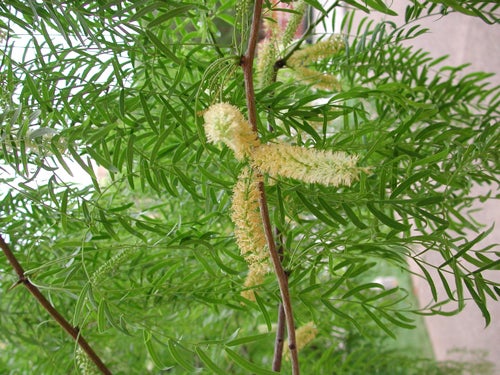
Mesquite blossom. (Photo: Larry Gilbert)
In modern culinary practices, mesquite is probably best known in for its use in grilling and barbecuing. Its woodchips are used with firewood as it imparts a smoky flavor to meat or whatever happens to be grilling. This is a practice mostly done in Texas, but mesquite wood is also shipped to Northern US and Canada as well for these same cooking purposes

Squirrel vs. mesquite: this one is munching on a mesquite outside PAT (Photo: Larry Gilbert)
Other parts of the plant are also useful. The Serrano and the Cahuilla people used the long thorns and the ashes of the mesquite to create tattoos. They also used the durable wood to make arrow points and tools. Furniture makers have long used this wood, nicknamed “Texas iron wood."
As the name suggests, “honey” mesquites with their aromatic blossoms are of great value to native bees and other pollinators. Commercial bee keepers in mesquite dominated range lands are able to produce some of the most delicate and light honey collected from the floral nectar of this plant by European honey bee. Mesquite is also a larval host to the Reickers blue butterfly, and the long-tailed skipper.
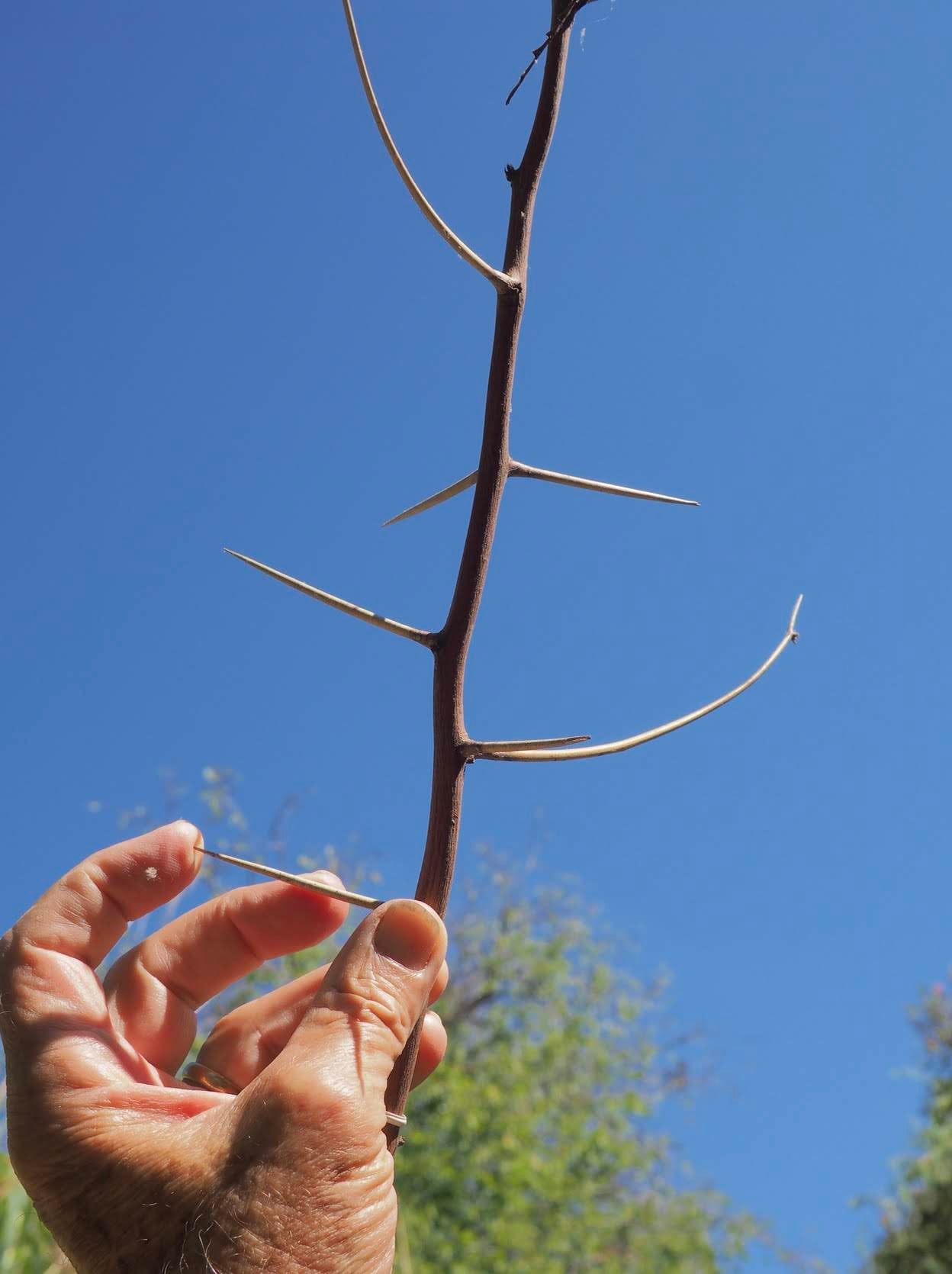
Mesquite thorns grow longer each time there is an attempt at eradicating the plant. (Photo: Larry Gilbert)
Many ranchers consider mesquite to be a range pest and attempt to eradicate it through root plowing, herbicide and burning. Overgrazing has also often led to reduction in grasslands, which has brought about denser populations of woody plants like mesquites. Historically, however, mesquites as a native species have had natural fluctuations in their numbers over time in their coexistence with other native plants.
In contrast to the notion of mesquite being “noxious,” this species can be healthy for local ecosystems in arid regions like southern Texas. Beyond the above-mentioned roles in pollination and animal food sources, mesquite provides beneficial services to the soil. Grasses around older mesquites are typically lush and green, and this is because mesquite leaves are nitrogen-rich as a result of possessing nitrogen-fixing bacteria in root nodules. As leaves drop in winter they are recycled, improving soil quality. This can reenergize soil overgrazed by livestock, thus benefiting ranchers. This was not understood until the 1970s. By that time, the plant’s status as a “pest” had already led to vast disruption of ecological diversity in South Texas as all woody vegetation in soil ecosystems were disturbed from vain attempts to eradicate this species.
SOURCES:
Abrahamsen, Elizabeth. “A Defense of Mesquite: The Most Important ‘Trash Tree’ in Texas’ Wide Open Country. (Accessed online: https://www.wideopencountry.com/mesquite-trees-the-most-important-trash-trees-in-texas/)
California Native Plant Society: Calscape. (accessed online: https://calscape.org/Prosopis-glandulosa-(Honey-Mesquite)?srchcr=sc57c805e90be3a)
Clark, C.E. “All About Mesquite Trees or Devil Trees.” Dengarden. December 13, 2016.
Gilbert, Lawrence. “An ecosystem perspective on the role of woody vegetation, especially mesquite, in the Tamaulipan biotic regions of South Texas.” Presented at the Tamaulipan Biotic Province Symposium in Corpus Christi, Texas October 1982.
Notable Trees at The University of Texas at Austin: A Pictorial and Information Guide. November 2015. Facilities Services. UT Austin
Plant Database, Lady Bird Johnson Wildflower Center. (accessed online: https://www.wildflower.org/plants/result.php?id_plant=prgl2)

